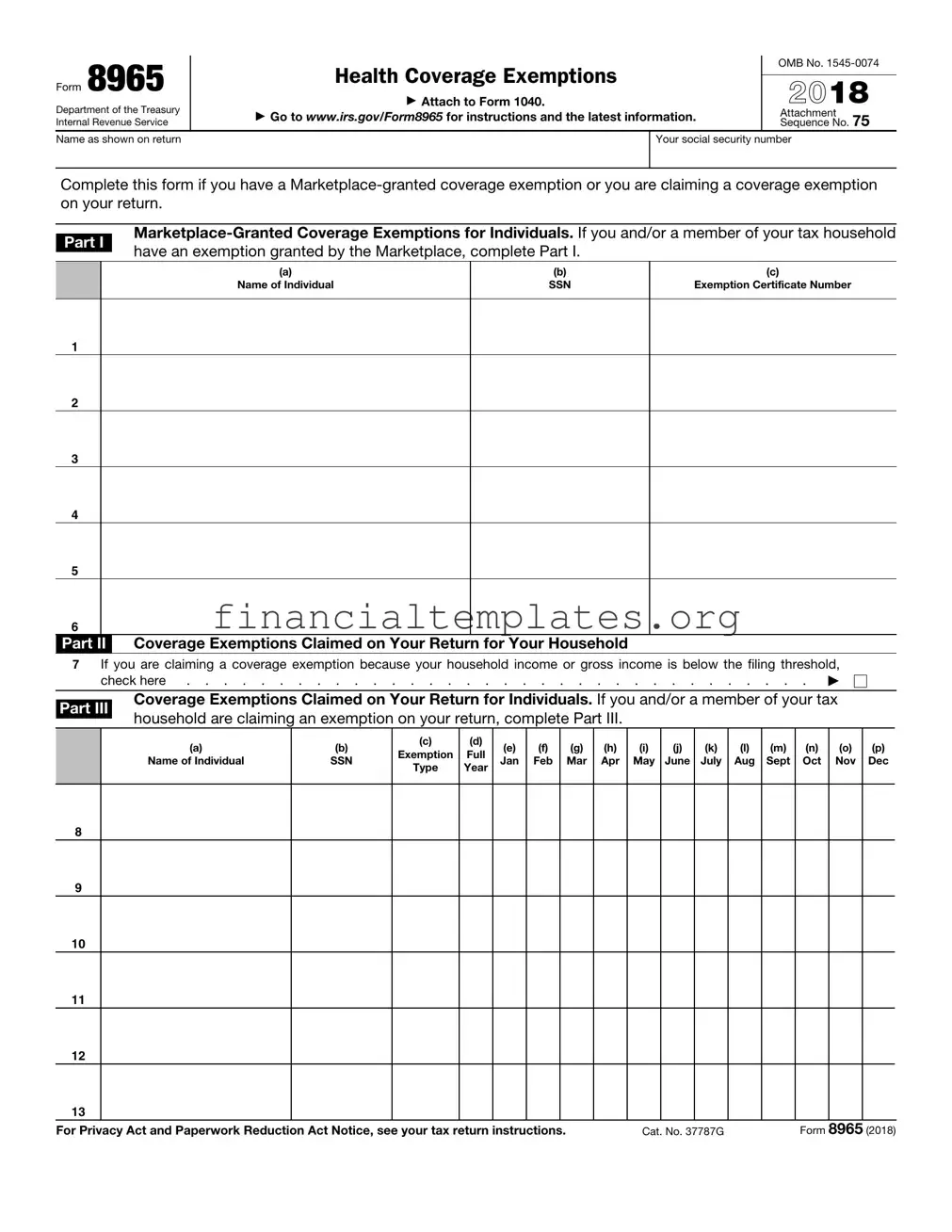The IRS Form 1040, "U.S. Individual Income Tax Return," is one document that shares similarities with the IRS Form 8965. Both forms are integral to the annual tax filing process for individuals in the United States. Form 1040 serves as the foundation for personal income tax filing, where taxpayers report their income, deductions, and credits. Form 8965, on the other hand, is an attachment to Form 1040 for those who need to report health coverage exemptions. Although their purposes differ—Form 1040 for reporting income and Form 8965 for reporting healthcare coverage exemptions—the connection lies in their shared role in the individual's tax filing process.
The IRS Form 1095-A, "Health Insurance Marketplace Statement," is another document related to Form 8965. Form 1095-A provides information on health insurance obtained through the Marketplace, including the coverage months and the amounts of any advanced premium tax credit received. Individuals use this information to complete Form 8965 if they're claiming a Marketplace-granted coverage exemption or for calculating the premium tax credit on Form 8962. Both forms are pivotal for individuals involved in the health insurance Marketplace, with Form 1095-A supplying necessary details for accurately completing Form 8965 or Form 8962.
Form 8962, "Premium Tax Credit," bears resemblance to Form 8965 in its connection to health insurance coverage through the Marketplace. While Form 8965 is used to report health coverage exemptions, Form 8962 is utilized by individuals who want to reconcile or claim the premium tax credit, which helps lower health insurance costs for those eligible. Both forms interact closely with health insurance coverage details obtained from the Marketplace, reflecting the financial aspects of health care coverage on taxpayers' filings.
The IRS Form 1095-B, "Health Coverage," also relates closely to Form 8965. Form 1095-B is issued by insurance providers and employers to report an individual's health insurance coverage status throughout the year. This information is crucial for taxpayers needing to complete Form 8965, as it helps determine if the individual falls into any exemption category due to their coverage status. While Form 1095-B reports health coverage, Form 8965 deals with exemptions from the coverage requirement, making them counterpart documents in the context of reporting health insurance on tax returns.
The IRS Form 1095-C, "Employer-Provided Health Insurance Offer and Coverage," parallels Form 1095-B and impacts Form 8965. Issued by employers, Form 1095-C provides information about the health insurance they offer to their employees. Similar to Form 1095-B, the details included in Form 1095-C assist taxpayers in determining whether they qualify for a health coverage exemption that would be reported on Form 8965. Both forms are integral for individuals in understanding their health insurance coverage and any implications it may have on their tax filings.
Form W-2, "Wage and Tax Statement," indirectly relates to Form 8965 through its reporting of an employee's annual wages and taxes withheld, which includes information on health insurance premiums deducted from wages if applicable. While its primary function is reporting income and tax details for employment, the information on healthcare coverage provided in the W-2 can influence the need for completing Form 8965 by indicating employer-provided health insurance, thereby affecting exemption eligibility.
Form 1040-SR, "U.S. Tax Return for Seniors," shares its foundational purpose with Form 1040 and, by extension, relates to Form 8965. Designed for taxpayers aged 65 and older, Form 1040-SR accommodates the same tax reporting needs as Form 1040 but with a format easier for seniors. Since Form 8965 is an attachment to Form 1040, it also connects to Form 1040-SR whenever exemptions for health coverage need to be reported, making both forms part of the broader income tax filing process for senior citizens.
The IRS Form 4868, "Application for Automatic Extension of Time to File U.S. Individual Income Tax Return," while primarily used to request more time to file Form 1040, indirectly associates with Form 8965. Filing Form 4868 extends the deadline for all associated tax documents, including any necessary completion of Form 8965 for health coverage exemptions. Thus, while serving different purposes—Form 4868 for an extension, and Form 8965 for reporting exemptions—they interact within the tax filing timeline.
Form 8822, "Change of Address," though administrative in nature, affects how individuals receive information regarding health insurance and exemptions, potentially impacting Form 8965 filings. If a taxpayer moves and files Form 8822 to notify the IRS of their new address, this ensures they receive all crucial tax documents and correspondence, including information that may affect their health coverage exemptions. The ability to correctly report exemptions on Form 8965 can depend on the timely receipt of notices and documents influenced by the accurate filing of Form 8822.
The IRS Form 8889, "Health Savings Accounts (HSAs)," complements Form 8965 by detailing contributions, distributions, and the tax treatment of HSAs, which can offer tax-advantaged ways to pay for healthcare costs. Although focused on HSAs, the utilization of these accounts and reporting on Form 8889 can indirectly influence the health coverage status and exemption needs reported on Form 8965. For individuals with HSAs, both forms work together within the realm of healthcare costs and tax implications.

